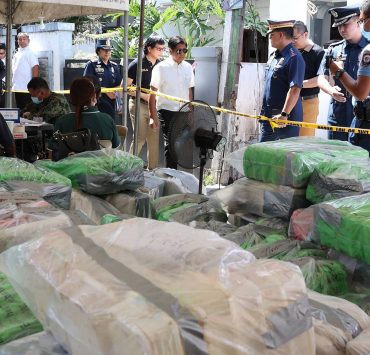Coast guard teams, newest missile system in PH-US drills
With tensions in the West Philippine Sea (WPS) again serving as backdrop, this year’s war games between Filipino and American forces have three unprecedented features.
For the first time, coast guard contingents from both countries are taking part in the “Balikatan” exercises that will start next week, with the two treaty allies keen on demonstrating tighter cooperation amid concern over China’s aggressiveness in WPS.
Also making a debut as a Balikatan participant—not just as an observer—is France, which is sending a warship to the drills, according to a military spokesperson.
For the pre-Balikatan program called “Salaknib,” which is ongoing, the US Army sent its newest ground-based missile system capable of firing Tomahawk and SM-6 missiles.
The arrival of the Typhon Mid-Range Capability (MRC) missile system was a “landmark deployment [that] marks a significant milestone for the new capability while enhancing interoperability, readiness and defense capabilities in coordination with the Armed Forces of the Philippines,” the US Army said in a statement.
‘Significant step’
The MRC arrived on April 11 at an undisclosed location in northern Luzon.
US forces currently have access to seven Philippine military bases in Luzon under the Enhanced Defense Cooperation Agreement: Naval Base Camilo Osias in Sta. Ana, Cagayan; Lal-lo Airport in Lal-lo, Cagayan; Camp Melchor Dela Cruz in Gamu, Isabela; Basa Air Base in Pampanga, Fort Magsaysay in Nueva Ecija; and Balabac Island and Antonio Bautista Air Base in Palawan.
“This is a significant step in our partnership with the Philippines, our oldest treaty ally in the region. We’re grateful to our partners in the Armed Forces of the Philippines and we’re excited to expand our security cooperation as we bring this new capability to Luzon,” said Brig. Gen. Bernard Harrington, commanding general of the 1st Multi-Domain Task Force, the unit that brought in the system.
Around 3,500 Filipino and American Army troops are training together from April 7 to 21 in parts of Luzon for the annual Salaknib, which focuses on external defense and serves as a prelude to the larger Balikatan exercises.
Philippine Army spokesperson Col. Louie Dema-ala said that after Balikatan, Salaknib would have a second phase for live-fire exercises using the Typhon.
Expanding
In a press briefing, Balikatan exercise agent Col. Michael Logico said the Philippine and US coast guards would join naval drills in the West Philippine Sea for division tactics, gunnery and search-and-rescue exercises.
The ships will sail beyond the 12-nautical-mile territorial waters off the coast of the Philippines. “We will be originating from Palawan and we will be doing it within the bounds of our EEZ (exclusive economic zone),” Logico said.
With a total of 16,770 participants expected from the Philippines and the United States, the 2024 edition of the Balikatan will be the largest since the first staging in 1991.
The number does not yet include delegations from the Australian Defense Force, French navy and other government agencies. The Philippine National Police, the Department of Information and Communications Technology, the Office of Civil Defense and the Presidential Communications Office are also joining.
Ship sinking off Ilocos
“When we start the execution, that’s when we’ll know the actual strength,” Logico said, adding that the drills were expanded this year to include more agencies concerned with national security.
The exercises will run from April 22 to May 10 in various areas of Luzon. They will again involve the sinking of a mock enemy ship, this time off the coast of Laoag, Ilocos Norte, a province near Taiwan and facing the West Philippine Sea.
Other drills include a cyberdefense exercise and an inaugural “information warfighter exercise’’ that will test the ability of the two militaries “to plan, command and communicate effectively in simulated scenarios,” according to a separate statement from the Armed Forces of the Philippines.
“If you take it into totality, the main goal of the exercise is to demonstrate the strength of our alliance and our willingness to defend our territory,” Logico said.
“I do not discount the possibility that this also sends a message to our adversaries, to our friends, to our allies and also to our like-minded partners,” he added. INQ

















